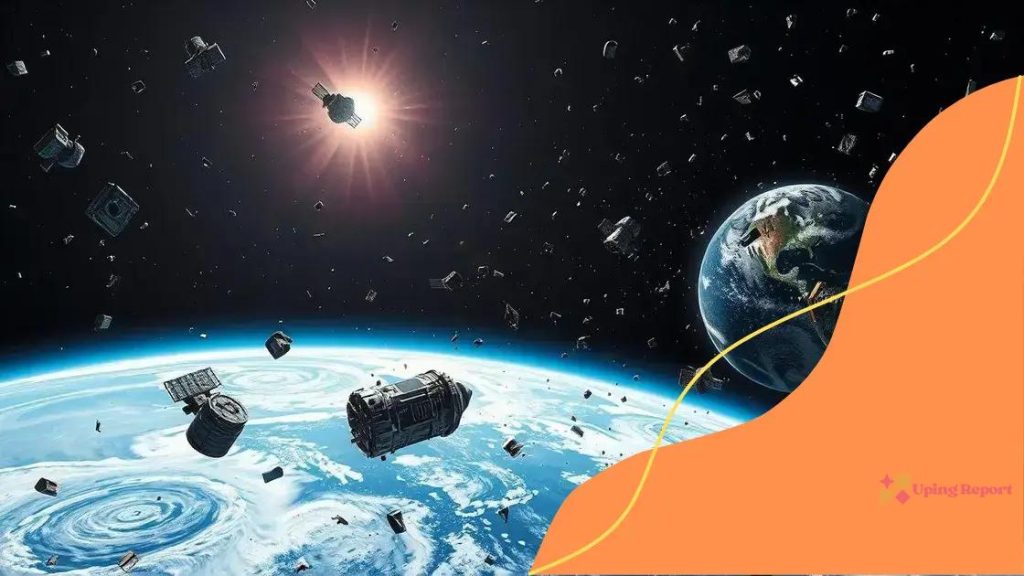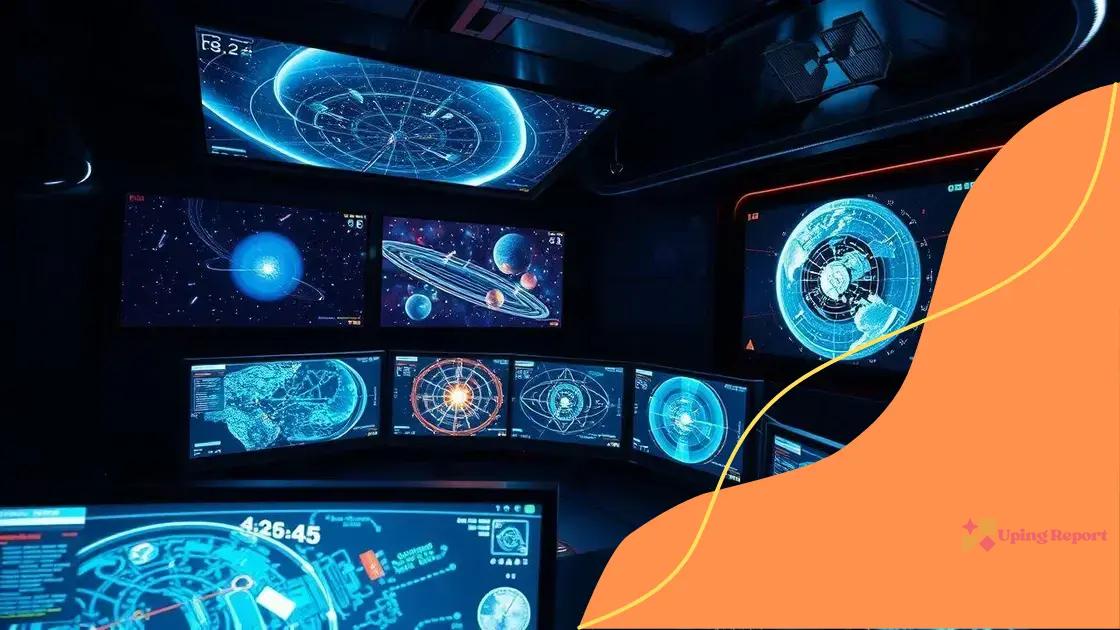Space debris mitigation efforts: reporting on international collaboration

Space debris mitigation efforts involve international collaboration to develop technologies for tracking, removing debris, and establishing guidelines to ensure sustainable space activities and protect future space exploration.
Space debris mitigation efforts are becoming increasingly vital as our orbit fills up with old satellites and debris. Have you ever wondered how nations can safeguard future space missions while tackling this pressing issue? Let’s dive in!
Understanding space debris and its impact
Understanding space debris is crucial for anyone interested in space exploration. As we launch more satellites and missions, our orbit is becoming cluttered. But what exactly is space debris, and how does it impact our future in space?
Space debris consists of defunct satellites, spent rocket stages, and fragments from collisions. This debris travels at incredible speeds, making it dangerous for active spacecraft. Even a small piece can cause significant damage. Monitoring this junk has become a priority in the space industry.
Types of Space Debris
Several categories of debris pose different risks:
- Defunct satellites: Satellites that are no longer operational but remain in orbit.
- Rocket stages: Components left over from launches that can drift in space.
- Meteoroid fragments: Pieces created from collisions between objects in space.
- Painted chips and screws: Small items that still can cause big problems.
The risks from space debris are increasing as more countries and companies launch their own missions. These debris pieces can collide with operational satellites and spacecraft, leading to costly damages or failures. For instance, in 2009, a defunct Russian satellite collided with an Iridium communications satellite. This incident resulted in thousands of new debris fragments, illustrating how dangerous this issue has become.
Impact on Space Missions
The presence of space debris also affects planning for new missions. Engineers must now consider debris when designing spacecraft. They often implement shielding to protect from potential collisions. Additionally, the cost of potential loss due to debris impacts mission budgets and timelines. As space activities expand, space debris mitigation will become even more critical.
Efforts are underway to clear up some of the existing debris. Innovative solutions, like capture nets and laser systems, are being tested. Countries are collaborating to prevent further proliferation of junk in space. However, public awareness about space debris and its implications remains low, even though it poses a significant threat to future space exploration.
In summary, understanding space debris and its impact is vital for ensuring a sustainable future for space exploration. The collaboration among nations, advancements in technology, and proactive management of debris can contribute to safer activities in orbit.
Current international regulations on space debris
Current international regulations on space debris aim to create a safer environment for all space activities. As the number of satellites increases, various organizations have developed guidelines to manage this growing problem.
The United Nations has taken significant steps to address space debris through its Office for Outer Space Affairs. In 2007, the UN adopted the “Space Debris Mitigation Guidelines,” providing a framework for countries to follow. These guidelines focus on reducing the creation of new debris and addressing existing debris.
Key Regulations to Consider
Several essential aspects of these regulations guide countries in managing space debris:
- End-of-Life Plans: Operators must create plans for deorbiting satellites after their mission ends.
- Collision Avoidance: Spacecraft must track and avoid potential collisions with debris.
- Design for Demise: Satellites should be designed to burn up upon re-entry to minimize ground risk.
- Monitoring and Reporting: Countries are encouraged to share data on existing debris and monitor changes in the environment.
Additionally, various space agencies have implemented national policies that align with these international guidelines. Agencies like NASA and ESA work to ensure their missions comply with debris mitigation measures. Collaborative projects often involve sharing technologies to track space debris and develop solutions.
However, challenges remain in enforcing these regulations. Not all countries adhere to the guidelines, leading to gaps in compliance. This disparity raises questions about accountability in space operation and the need for stronger international agreements.
Furthermore, as more private companies enter the space sector, integrating them into existing regulatory frameworks is crucial. These new players may sometimes prioritize short-term gains over adherence to best practices for space debris mitigation. Encouraging compliance through incentives or stricter regulations may be necessary to protect our shared space environment.
Technology innovations for debris tracking

Technology innovations for debris tracking are crucial in managing the growing issue of space junk. As our reliance on satellites increases, so does the need for effective tracking systems.
One of the most significant advancements in debris tracking is the development of radar systems. These radar installations can detect objects in space, ranging from larger defunct satellites to tiny fragments. By utilizing advanced algorithms, they can differentiate between debris types and assess potential collision risks.
Key Technologies in Debris Tracking
Several key technologies contribute to effective debris tracking:
- Ground-Based Radar: High-powered radars scan the skies, providing real-time positions of larger debris.
- Optical Sensors: Telescopes equipped with optical sensors can track dimmer and smaller pieces of debris.
- Satellite-Based Systems: Special satellites are designed to monitor and track debris from space, offering a different perspective on the problem.
- Machine Learning: By analyzing data, machine learning algorithms can predict debris movements and help prevent collisions.
In addition to detection, innovations also focus on improving data analysis. Enhanced simulations allow operators to visualize debris movements over time. These tools help determine safe trajectories for satellites, ensuring they steer clear of potential hazards. Collaboration between government agencies and private companies is essential for the development of these innovative tracking systems.
Some companies are even exploring new technologies like laser ranging, which can provide precise measurements of debris distances. This cutting-edge method can track even the smallest pieces of junk in orbit, greatly improving safety for current and future missions.
However, despite these advancements in debris tracking, challenges remain. The increasing number of satellites complicates the tracking process, and managing the vast amount of data generated requires sophisticated systems. Successful navigation through this complicated environment will depend on continued innovation and collaboration.
Collaborative efforts among space-faring nations
Collaborative efforts among space-faring nations are essential for addressing the challenges posed by space debris. As the number of satellites increases, so does the need for international cooperation to manage and mitigate the risks associated with these hazards.
Countries recognize that working together is vital for the future of space exploration. Initiatives like the Inter-Agency Space Debris Coordination Committee (IADC) advocate for sharing information and best practices in debris mitigation. This committee includes space agencies from several leading nations, including NASA and ESA.
Key Collaborative Initiatives
Some notable collaborations in space debris management include:
- Data Sharing: Nations exchange data on tracked debris to improve monitoring systems.
- Joint Research Projects: Collaborative research explores new technologies for debris removal and tracking.
- International Guidelines: Developing and adhering to international guidelines ensures all countries follow similar practices.
- Space Situational Awareness: Programs that enhance awareness of objects in space help prevent potential collisions.
Through these initiatives, nations can combine their resources and expertise to tackle complex problems. For instance, joint exercises simulate scenarios involving space debris and test responses to potential collisions. The practice strengthens communication and prepares all involved for real-life events.
Additionally, public-private partnerships have emerged to foster innovation in debris removal technologies. Companies are collaborating with government agencies to develop methods that can safely remove space junk from orbit. This new trend shows a commitment not only from nations but also from the private sector in addressing the challenges of space debris.
Even with these efforts, many challenges remain. Disparities in capabilities among nations can hinder collective progress. Wealthier nations with advanced technologies often lead these efforts, leaving smaller countries at a disadvantage. Addressing these inequalities is crucial to effective global cooperation.
Furthermore, there is a growing need for stronger legal frameworks to ensure accountability in space operations. The lack of binding agreements has led to some nations ignoring guidelines, complicating collaboration efforts. As we face the reality of increasing space debris, fostering a culture of partnership and responsibility among space-faring nations will be key to a sustainable future in space.
Future strategies for sustainable space activities
Future strategies for sustainable space activities focus on preventing the creation of new space debris and managing existing hazards. As more countries and private companies venture into space, it’s vital to develop practices that protect the orbital environment.
One key strategy is implementing clearer guidelines for launch operations. Launching organizations can ensure that rockets are designed to minimize debris production. Enhancing the engineering of rockets can help reduce fragments generated during launches. For instance, employing more efficient fuel can decrease the risk of creating debris during firing.
Innovative Solutions for Sustainability
Several innovative solutions are emerging to make space activities more sustainable:
- Active Debris Removal: Technologies like nets, harpoons, and robotic arms are being developed to capture and remove large pieces of debris.
- Satellite Servicing: Repairing or refueling satellites can extend their lives and reduce the need for new launches.
- End-of-Life Protocols: Mandating that satellites are removed or deorbited safely after use ensures they do not become space junk.
- Tracking and Coordination: Improved tracking systems help satellites avoid collisions by providing real-time data about nearby debris.
International cooperation is also essential for implementing these strategies effectively. By sharing technology, research, and best practices, nations can work together to reduce space debris and ensure a sustainable future in space. Programs like the Space Safety Coalition encourage collaboration between governments and private entities, fostering an environment of shared responsibility.
Another important aspect of sustainability is public awareness. Educating the public about the risks associated with space debris can create pressure for more stringent regulations. Advocacy groups and educational campaigns can play a significant role in promoting the importance of sustainability in space.
At the same time, as technology continues to evolve, there is a need for flexible strategies that adapt to new challenges. This adaptability will be crucial in addressing unforeseen issues that arise as the space environment changes.
FAQ – Frequently Asked Questions about Space Debris Mitigation
What is space debris and why is it a problem?
Space debris refers to defunct satellites, spent rocket stages, and fragments from collisions, which pose risks to operational spacecraft.
How can nations collaborate to address space debris?
Nations can work together by sharing data, developing joint technologies, and establishing international guidelines for debris mitigation.
What technologies are being developed to track space debris?
Innovations include ground-based radar, optical sensors, and satellite-based monitoring systems to detect and track debris.
What strategies can ensure sustainable space activities in the future?
Implementing end-of-life protocols, investing in active debris removal technologies, and enhancing public awareness about space debris are crucial for sustainability.
